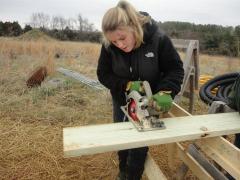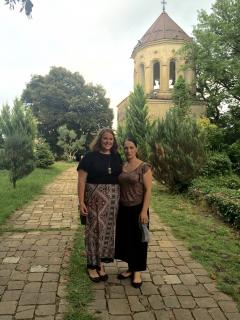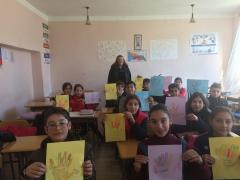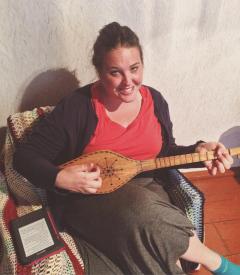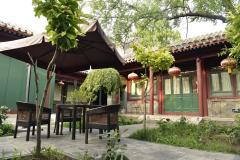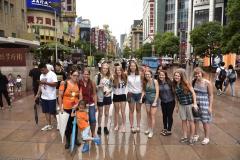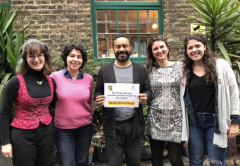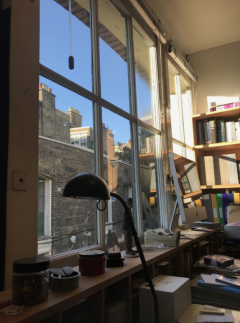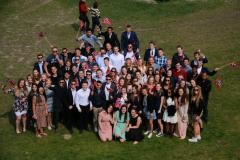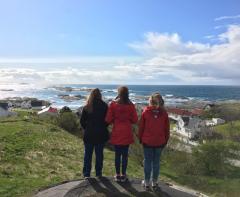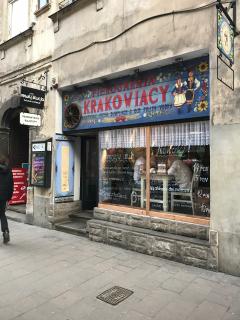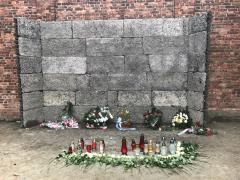Articles + Blogs
ENG 485 is a hands-on practicum for English majors seeking real-world experience in designing and implementing writing projects outside the classroom. These ENG 485 interns have partnered with the Office of International Education to create a series of articles on various internationally-themed topics.
- The toughest job you’ll ever love: Volunteering for the Peace Corps
- 10 Things Every Study Abroad Student Should Do
- Exploring China, the Middle Kingdom
- Living in London on a Budget
- An American in Jeju: Holly Thomas on working abroad
- Interning with the Tiny Owls
- Working abroad: My year in Norway
- Immersed in History: Krakow, Poland
THE TOUGHEST JOB YOU'LL EVER LOVE: VOLUNTEERING FOR THE PEACE CORPS
By Nellie Owens
Twenty-five year old Katie Sullivan - known to her foreign friends as “Kate” - graduated from SUNY Oswego in May 2015. Now, nearly two years later she is volunteering in the Republic of Georgia as an English teacher through the Peace Corps.
Curious about her experience, as well as the program, I asked Katie if she might be willing to do a Skype interview for SUNY Oswego’s Study Abroad Department.
Half a world away
Katie and I agree to Skype at 10am my time. The nine hour time difference means it is 7pm in the country of Georgia and Katie is finished with her teaching for the day.
Initially, our connection is poor and our Skype call drops several times. I’m not sure if we will be able to go through with the interview, actually. But, after a few minutes of telecommunicating, we decide to switch to Facetime and the call comes through relatively clear.
As my image “depixelates,” I see Katie’s face for the first time. She is a vibrant young lady who radiates enthusiasm. Katie tells me that she is originally from Westchester, NY, which means that she is quite a ways from home at the moment. Still, I can also tell from our conversation that she is right where she wants to be.
Headed to Georgia
After we both briefly introduce ourselves, I ask Katie what drew her to the Peace Corps. Her answer is both honest and sincere:
“Volunteerism has been a huge part of my life since middle school,” Katie says. “In college, I was the President of the Habitat for Humanity Club at SUNY Oswego: a non-profit that brings people together to build homes and communities. I took an alternate spring break with SUNY Owego/HFH every chance that I could. One year I went to the Dominican Republic and taught English for a week. I also donated time at my church at home. I have a passion for learning about other cultures. I interned for the Department of State for the Bureau of
Educational and Cultural Affairs, and talked with quite a few people who recommended that I consider joining the Peace Corps."
Katie continues, telling me why she chose to serve in the country of Georgia specifically. "When I spoke to a recruiter on campus, she gave me a few options,” Katie says. “I was open to going anywhere at the time. I didn’t have a set location I was super passionate about. But, she mentioned that I would be a good fit for Georgia, China, or Micronesia. I was considering Morocco's Youth Development program, initially, but after talking to the recruiter and doing my research I ended up applying for Georgia. I had studied abroad for six months in Melbourne, Australia. And I knew people from China. But, Georgia was like nothing I had ever experienced. It was really new and it seemed liked the best option for me.”
The Peace Corps
As Katie tells me about her options, I realize that I don’t actually know very much about the Peace Corps at all. I ask her if she could explain what the program is and how it works.
She smiles. “Yeah. Of course!
“The Peace Corps was started on March 1, 1961 by John F. Kennedy to promote world peace and friendship. Peace Corps has been in 141 countries and are currently in 65 countries. Currently, we are in the regions of Africa, Asia, the Caribbean, Central America and Mexico, Eastern Europe, Central Asia, North Africa and the Middle East, the Pacific Islands, and South America. We promote peace by meeting the needs of a particular community with trained men and women. But, we are also here to promote the understanding of America to the country we are in, as well as bring back information about the country we served in to America when our service is over.”
Katie states that, at present, the Peace Corps has six different sectors of service called “projects and initiatives.” They include English Education, Health, Youth and Development, Agriculture, Environment and Community Economic Development.
Applying, training and serving
“Application timelines vary by country and such,” Katie says. “For me it was only a month but it can be longer. You should think about applying a year in advance. After you get accepted, you have to get cleared medically. They will check every medical thing that you can think of,” she adds with a laugh. “You need to be in good health if you are going to serve in another country and the Peace Corps takes that very seriously - which is a very good thing if you think about it. Once you get medically cleared and pass all your background checks, they will get you ready for your staging. We [as volunteers] make a commitment of 27 months; 3 are for training and 24 are for service. You do get a housing and living stipend. Some of the money I get goes to my host family for food and utilities. We get a small amount each month that we can use for various reasons - to buy food, clothing, internet, phone minutes etc. I sometimes use this to travel for different events and projects. But, the work you do is first and foremost volunteer work.”
Daily Life
I wonder what Katie’s everyday life looks like, though. Who does she live with and where does she work? I ask her if she can fill me in on these details, as well as tell me a bit about her daily routine.
“Sure,” Katie replies. “I live with a local host family and work in a public school. From Monday to Friday I teach from 9am to usually 1 or 2pm. I just teach English. In my school, there is first through twelfth grade. I have taught every class at least once, but I usually teach the younger kids. I teach Culture Club and Reading Club and usually get home around 3-4pm. One day a week, I travel to another village to get tutored in Georgian. There is another volunteer there, so we usually talk about projects."
“In the evenings I work on different committee projects,” Katie says. “They're not official Peace Corps committees, but are encouraged by them. They're all run by PCVs but not by staff. One is a breaking gender stereotypes committee called Saqartvelo Smashes Stereotypes, which I helped create. I also help with the National English Spelling Competition (NESC) of Georgia, a Model U.N. committee and History Project Georgia. There’s also lesson planning for every week day."
"Weekends are scattered,” she adds. “I work on projects, conferences, workshops. I very rarely travel for leisure, because I am so busy. But, sometimes I go to nearby towns and villages. I live close to a canyon, and I
like to go on walks. There is a lot of breathtaking nature here and the fall colors are beautiful."
Georgian Culture
Katie doesn’t need much prompting when I ask her about the local culture.
“I love it here!” she exclaims. “Like anywhere in the world, everyone has their own culture. Georgia loves its arts. Dancing and singing are a huge part of their culture. Many of my students dance, sing or play instruments. One of my favorites to listen to is the Panduri! I hope to learn how to play it before I leave. It is really cool. The food is also really good. I like how ingrained in the culture it is. Each region has its own food. Some famous foods include: Khachapuri, Ghomi, Khinkali and Pelamushi. During the holidays we have big dinners called Supras. Plates are stacked on top of each other at these huge feasts!” she says with a smile. “There is a ton of food!”
“Georgia was also one of the first countries to make wine,” Katie adds. “I think they were the first, actually. So, wine is a big part of the culture here and a staple at supras. Toasting is very special here too. They have a tamada who is the lead toaster who tells stories and speaks beautifully. There are certain toasts said at every supra including to God, the dead, and the hosts. Georgians love to express themselves through art and food and I think that’s beautiful.”
Unending support
Katie’s comments and descriptions are quite compelling. I can tell from her facial expressions and body
language that she means every word she says; she really does love living in Georgia! But, I can’t help but wonder how safe it is to live and serve in some countries. I ask Katie about this, and whether or not she has ever felt unsafe while in serving abroad.
“I can’t say that I have,” Katie says. “I actually feel super safe here. I am supported by the people who run the Peace Corps program and I feel like they have really prepared me for living in this country. There is also a real community mentality here; people are eager to help, as well as talk with you (especially if you take the time to learn the local language)."
“But, I do understand that fear,” Katie adds. “It's definitely okay to feel like you are going to miss home; it’s an unknown area - that’s one of the best and scariest parts about it. The biggest thing before moving to another country is doing your research. Every site is different. No one has the same experience. It’s all unique and it can be challenging at times. But, it is such a rewarding experience. It’s the toughest job you’ll ever love. Even on a rainy or snowy day, I can’t help but be happy. When you volunteer, you have to understand: you are doing great things.”
Why serve?
Katie is definitely passionate about volunteering. I do want a concrete answer, though, as to why she is serving in the Peace Corps. I ask her if she would be willing to share with me the main reason she has given up her time for this endeavor.
She nods. “For me, I love being able to see the outcome - and providing opportunities or sharing skills that people may not have had otherwise. It’s actually not the outcome, so much as knowing that I helped someone - knowing that I may have changed someone's life for a moment, or for years to come,” Katie says. “That’s what it’s all about. I am learning as much as I am teaching. I spend so much time getting to know the students I teach and work with. As I am teaching them, they teach me why their country is so unique and why people would want to live here. I am learning about other cultures, breaking from misconceptions, and seeing people in a new light."
“Everyone in the Peace Corps is here to make the world peaceful and to understand other countries better. Every culture and country is unique and that should be embraced.”
Looking ahead
As our interview draws to a close, I ask Katie what her plans are after her service in Georgia is over.
“My goal is to go back to university to study Peace and Conflict Study,” she says. “I am leaning towards a focus in Gender. Eventually, I want to work for the State Department with Youth and Cultural exchange programs. I think this experience has opened my eyes to how people live and work in a community - and how to make it better for them (based on what they need). It’s really helped me to develop skills that I will use later in life, and is something that I am sure will be with me forever.”
With the mind to make a difference, Katie is what the Peace Corps would define as a motivated changemaker. I am thankful I had the opportunity to interview her and learn not only about the Peace Corps and country of Georgia, but also about serving and volunteering in general. There can never be too many people who make it good for the others - who work to meet their needs - without expecting anything in return. I am glad that Katie has such a mindset. Thank you, Katie for the interview – and best of luck in the time ahead!
To learn more about the Peace Corps, visit https://www.peacecorps.gov/.
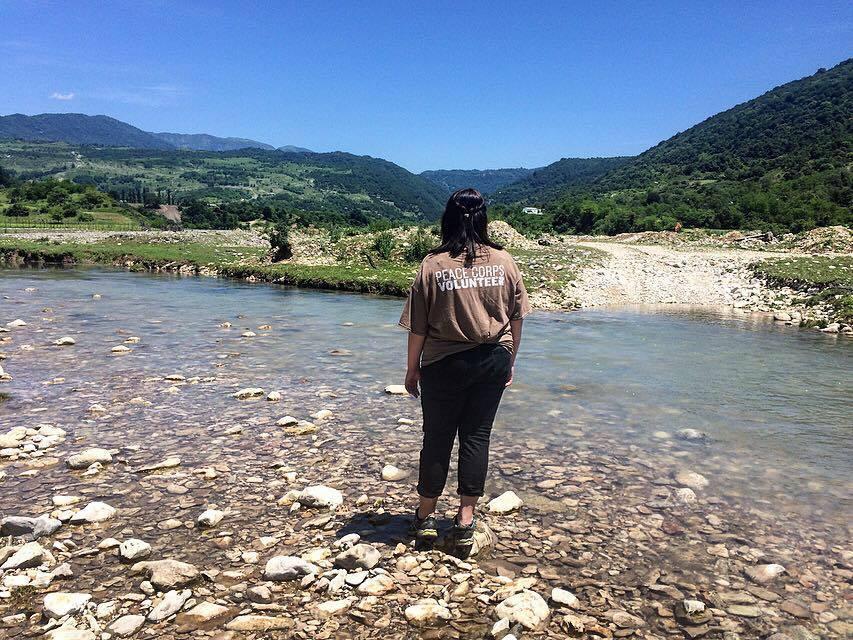
10 THINGS EVERY STUDY ABROAD STUDENT SHOULD DO
Nellie Owens
The decision to study abroad is an important one that can impact the rest of your life. Below are some essential guidelines for those of you who are considering studying abroad.
1. Meet with your advisor
Don’t forget to meet with your advisor and make sure that they are aware of your intention to study abroad. This seems rather obvious, as they will need to sign off on your paperwork beforehand. But, it is always better to let your advisor know your plans as early as possible, so that they can go over your degree progress with you and make sure that you are still on track for graduation. Besides that, your adviser may have relevant and useful advice. Using the mentors and resources that are available to you can open up an abundance of opportunities.
2. Check out financial aid opportunities
If you are a recipient of Financial Aid, your aid money can be applied to your study abroad experience. Make sure that you meet with the Financial Aid Office and see what kind of options are best for you to pursue, financially. In many cases, students take out small loans in order to study abroad, but it should also be realized that there are scholarships and government assistance available for some students who choose to study abroad. The Benjamin Gilman International Scholarship Program, for example, offers more than 800 scholarships every semester to Study Abroad students. Some more local level scholarships, such as SUNY Oswego’s GETGO scholarship, will also help to provide Study Abroad students with funding for study abroad airfare.
3. Apply for a visa as soon as possible
If you are studying abroad, most countries require that you obtain a visa. Basically, this is a document (often fixed to one’s passport) or a card that indicates your legal residency for an indicated time frame. Your visa may also be electronically attached to your passport and only show when scanned at Customs. Some visas can be quite expensive costly to apply for and, in some cases, the application process is quite lengthy. It’s a very good idea to apply for a visa under the supervision, or with the assistance, of someone who has applied for a visa before. But most governments also have information on their website to help with the process.
Once your visa paperwork has been filled out, you will submit it to the consulate. This may be done in person, via the mail, or online, depending on the country you're visiting. The time it takes to receive a response regarding your visa varies greatly from country to country. Sometimes, you will receive a response in a few days and other times it can take a number of months. You should apply for your visa as soon as you have confirmation of your study abroad placement
4. Make sure you have health insurance
Health insurance is also quite important; you need to make sure that you are covered in the case that you become ill or get in an accident while studying abroad. When a student is registered through a university to study abroad in a foreign country, they are often covered through a university insurance, such as GEOBLUE. In some cases, however, insurance may be offered through a study abroad program or an internship site. Make sure you do your research before leaving the United States, so that you can be sure you are covered.
5. Find a POA
If you are leaving the country, that means that you will have a limited ability to perform some of the more practical tasks that life may demand. It can be a very good idea to give someone you trust (such as a parent or guardian) Power of Attorney (or POA), especially if your time abroad is longer than three months. Basically, Power of Attorney gives the appointed individual authority to sign for you, as well as perform limited actions in your name. This means that, under your approval, they can make monetary deposits and withdrawals, and that they can represent you when necessary. A POA needs to be signed in front of and by a public notary, and can be revoked at any time.
As well as giving someone POA, it is also a very good idea to leave them with copies of your passport. In the case that any of your important documentation is lost or stolen, you can be assured that you have copies at home.
6. Do your research
It is of the utmost importance that you research the country that you are going to study in. You need to understand some of the culture beforehand, so that you know how to conduct yourself in various social situations. Spend time researching other cultures, and learning things about them. This will give you insight into how people might react in a variety of situations, as well as the reasons why they behave the way they do.
It is also extremely important that you are aware of local laws and general cultural expectations, even about things as simple as traffic signals. As a student in a foreign country, the last thing that you want to do is make yourself a target or brand yourself as an “ignorant foreigner.” Doing research can help to make you look like a competent, well-seasoned traveler, or even a citizen who knows their way around.
7. Be Respectful
Not everyone is going to do things the way you do. In fact, their culture or lifestyle might encourage the exact opposite. Be respectful of the differences in various cultures. Show tolerance, and have an open mind when it comes to things that you do not understand. Disrespect for someone else’s culture or way of doing things will definitely inhibit effective communication.
Furthermore, if you have done your research on other cultures and communication styles, don’t be afraid to apply what you have learned. When studying abroad, you don’t need to change your identity, but, in many cases, it is expected that you will adhere to the cultural expectations and norms of the country where you are studying. By being respectful of a country's social etiquette, and following their social norms, you will be able to communicate more effectively.
8. Learn the language
Needless to say, language can be a big barrier to effective communication. This is why it is also essential that you put forth the effort to learn the language of the country where you will be studying (if it is different than your own). While studying in a foreign country, you will need to be able to understand directions and properly communicate your own needs, thoughts and opinions.
9. Ask questions
If you don't understand something, don't be afraid to ask. It is better to admit that you need help, rather than internalize any problems or frustrations you may have. Asking a question in a professional manner may help you more than you realize. Not only are you likely to get a more clear answer to what you are wondering about, but you also build professional relationships and convey your own motivation and interest in completing the task at hand.
10. Open your mind
Lastly, open your mind! Get to know people: network professionally and make friends! Travel, explore and try new things! The world we live in is much bigger than the United States and you won't regret your decision to study abroad if you use your time right.
Learn more about SUNY Oswego's study abroad programs at https://www.oswego.edu/international/program-search
EXPLORING CHINA, THE MIDDLE KINGDOM
Nellie Owens
So you want to study abroad? Maybe? You’re thinking about it, anyway. And for good reason!
Studying or working abroad can be an enlightening experience. It can really open our eyes to the world around us – different cultures, foods, people and lifestyles.
During my year abroad, in which I completed an international internship and co-op for a Norwegian non-profit, I had the opportunity to travel quite a bit. One of the countries I visited was China, stopping in the cities of Beijing, Shenzhen, Shanghai and Hong Kong.
Here, I wanted to share with you a few facts, tidbits and cultural takeaways from my time in the ‘Middle Kingdom.’
The Heart of Ancient Chinese Culture
China’s capital, Beijing, is a truly unique city. It is home of the Hutong, one of the most culturally rich areas in the country. During my time in Beijing I stayed in a siheyuan, which is a traditional Chinese home in the Hutong.
Hutongs are long, narrow alleyways that contain traditional residential housing. The Hutong area is protected by the country's leadership, and this is one of the reasons it is Beijing's most attractive place to live. Dating back 800 years, this area reflects ancient Feng-shui philosophy. According to Feng-shui, the arrangement of household objects and the architecture of your home can affect your health and well-being. Many people living in the Hutong believe they will experience happiness and a long life because of the way the Hutong area is structured.
The Forbidden City
Beijing is also home of the Forbidden City. This palace complex was China's government seat during the Ming and Qing dynasties from 1422 to 1912. During the Imperial era, the area was closed to ordinary people; only the imperial family and the court had access to it (hence, the name “forbidden”).
Today, the palace complex is open to tourists and receives over nine million visitors every year! There are English maps and audio guides to help foreigners navigate the ‘city,’ but - interestingly enough - most sources (whether a map, sign, app, or guide) do not agree on the English translations of the names of various buildings. For me, this added to the mystery and secrecy surrounding the area. It seemed that there was still something forbidden about its history, even after years of being open to the public.
The Great Wall
The 8851 km long Chinese wall is probably China’s greatest tourist attraction. Historically, the Great Wall was built as a defense under the Ming Dynasty in the 1300s. Approaching enemies could be seen from the watchtower, and those along the wall were supposed to set off a smoke signal if anyone was spotted.
Today, the entrance is posted with signs in Chinese, which resemble advertisements. You can either hike the wall, or ride up on a cable car to one of its more preserved parts. The wall is quite expansive. The day that I visited, the sky was clear and you could see it for some length. A local told us that smoke from the city often blows through the region, and it is rare to get a good view (more than a section or two).
Selfies and Visitors
In the city of Beijing, and in other less globalized regions of the country, the locals are not used to Western tourists. Approximately 95% of tourists are Chinese tourists who travel from other parts of the country (most often to see the Great Wall or Forbidden City).
To see a Westerner, then, can be quite a shock. It wasn’t uncommon for people to stare at me or my friends, or even ask to take a picture with us. At one point, one of my friends had a line of more than ten people that wanted to pose with her.
The Shiny City of Shanghai
Despite the fact that Beijing is the country’s capital, Shanghai is actually the biggest city in China. In comparison to Beijing, Shanghai was significantly cleaner and more modern.
In Beijing, it was difficult to find people that understood English, but this wasn’t the case in Shanghai. A much more globalized city, it was easier to communicate with others, as well as recognize commonalities with American culture. Most people had a smartphone, and wore westernized clothing like t-shirts.
Transportation
Since I come from rural Upstate New York, we don’t really have large forms of public transportation like subways or trolleys, ferries or trains. Needless to say, I was thoroughly impressed by China’s massive subway system. (I would assume an effective transportation system like that would be needed when there are 1.4 billion people in your country and .2 cars per capita.)
Besides the subway, transportation could be quite unreliable. Taxis were extremely hard to catch (it was almost impossible to hail down two for our large group), and buses came at inconsistent intervals in some locations. China Southern Airlines, one of the airlines we flew, also delayed our flight three times. My friend said this was normal, noting that the cheaper flights usually delay 60% of the time.
Food
Chinese food (that is actually made in China) is authentic and full of flavor. I am a big fan of Chinese food, so eating traditional Chinese food in China (like Peking duck) was definitely a highlight for me. One should use caution, however, when going out to eat. There are no health code regulations/sanitary requirements, so it was important for my friends and me to research restaurants before just eating anywhere (here, Yelp helped tremendously).
There is also a specific culture that surrounds Chinese meals. In America, we are accustomed to the idea of grabbing food to go. In China, however, family meal times are highly valued. Every meal is hot (including breakfast). The Chinese eat their food around round tables and on each table is a smaller round rotating tray (what we Americans might refer to as a ‘lazy Susan’). This smaller tray can be rotated to provide equal access to the food for everyone seated at the table. Traditionally, the Chinese also eat with chopsticks, but most restaurants provide silverware upon request.
“Hong Kong is not China!”
Perhaps my introduction - in which I said I visited the Chinese city of Hong Kong - was a little misleading. Many would argue that Hong Kong is not a Chinese city (especially Hong Kong residents), even though it is technically a part of China. In fact, this area (previously a colony of England) is an autonomous region with its own government. Hong Kong has their own currency, Hong Kong dollars, which replace the Chinese yuan - and you have to show your passport if you want to travel back and forth from mainland China.
A vibrant, globalized region with massive shopping malls and skyscrapers, this city was fun to explore in the evening when people weren’t rushing to and from work. My friends and I took a double-decker bus to and from the city, which offered a bird’s-eye view of the country’s elaborate highway system.
Always More to Learn
My travels through Beijing, Shenzhen, Shanghai and Hong Kong taught me a lot about the country, culture and history of China. I learned and experienced far more than I could relay in this short article.
But, I also understood that there is much more to learn.
We can’t possibly understand another country and culture in its entirety just by travelling through it. We can, however, make the most of every opportunity to try to understand - to be active learners wherever we are. Then, whether we are travelling, working or studying abroad, we are sure to benefit from our international experiences.
Interested in learning more about SUNY Oswego's study abroad programs to China, and other locations around the world? Visit https://www.oswego.edu/international/program-search
LIVING IN LONDON ON A BUDGET
Lauren Sanford
I felt truly lucky to have spent four months of my life studying, working, and living in London. It’s an exciting place with opportunities at every corner: from concerts, to museums, to restaurants and nightclubs. There was always something going on, but little did I know in preparing for my trip just how expensive it could be. It was frustrating at times, because I wanted to go to every show, visit every pub, and spend my money on whatever I pleased… but on a limited college budget. If you’re considering traveling or studying abroad, you might worry about overspending, or about not having enough money to begin with; it can be especially tricky with the conversion rate from American dollars to British pounds. At the moment, $1=£0.76, so $20 would equal about £15. My tip for you is: don’t panic! Spending your money sparingly can go a long way. While I was in London, I figured out ways to make the most of my experience on a limited budget. London doesn’t have to be expensive ~ it’s what you make of it!
Grocery Shopping & Eating Out
One of my favorite parts about living in London was trying a bunch of different food. People from all over the world lived in the city, which meant restaurants from different cultures were scattered throughout London’s thirty-two boroughs; Indian, Greek, and Thai food are particularly popular in the London scene. Not to mention authentic English dishes, like meat pies, yorkshire puddings, and fish and chips, plus almost any type of beer or cider you could imagine, are served at every pub in London. Unfortunately, I soon became very aware that I would not be able to afford eating out every night of week, no matter how I wanted to. Lucky enough for me and my flatmates, we lived in a cozy apartment complex directly on top of a grocery store. Sainsbury’s was our favorite store to shop in: they had lower-priced groceries compared to other supermarkets, and they offered a Nectar card, the store’s rewards card, which complied points depending on how many items you purchased and how much money you spent. These rewards points could be used during later purchases, which ended up saving me a good amount money. Healthier groceries were also relatively cheap, especially compared to the United States. I typically bought apples, a bundle of carrots, fresh bread, eggs, and hummus. The American foods, like Ben & Jerry’s ice cream, Reese’s Puffs cereal, and Poptarts were extremely pricey in London, which quickly squashed my desire for the unhealthier options. Fun fact: a regular box of Oreo cookies, costing around $4 in the United States, is priced at about £7.50 in London - this is about $10! (I didn’t need them that badly.)
We frequented Camden Market almost every weekend, one of the more popular spots in London, to shop around, but specifically to indulge in the most amazing Venezuelan street-sandwiches. Camden Market is notorious for its wide variety of inexpensive ethnic street food, like Chinese, Mexican, Indian, Italian, Pan-Asian, and American cuisines; many of the vendors also catered to vegetarian and vegan foodies. The market offered more than just food, with about 1,000 shops selling vintage clothes, candles, jewelry, art, souvenirs, and so much more.I only really went out to eat at nice restaurants and pubs for friends’ birthdays and special occasions. But on the weekends, and even throughout the weeks, when our refrigerators were empty and our stomachs were hungry, my flatmates and I hit up the best markets in London; our favorites were Camden, Borough, and Portobello. The markets were open almost everyday, throughout the day, and featured vendors selling anything you can think of. At Borough Market, located in the heart of London, there was an enormous section dedicated to selling all kinds of baked goods, including thousands of loaves of bread, donuts, brownies, cookies, and cakes. At the market I also tried my first scotch egg, which was actually much tastier than I had expected. (A scotch egg is a hard-boiled egg, wrapped in sausage or meat and covered in breadcrumbs… and then fried. Trust me, it’s worth the try!)
At Portobello Market, which I only visited once (sadly), I tried falafel, a fried ball or patty made from ground chickpeas, for the first time: it was AMAZING. Unlike the two other covered markets, Portobello Market is a street market in Notting Hill, London. You could walk along the street for miles, and it wouldn’t seem to end. They not only sold different ethnic meals, but a lot of the vendors sold fresh, local fruits and vegetables, sometimes cheaper than you’d find in a grocery store. All of these markets sold delicious food at low costs, but the best part about visiting them was definitely experiencing London’s unique culture.
Clothes Shopping
I tried very hard to suppress the temptation to spend my entire budget on cute clothes and accessories from the thousands of shopping centers throughout London. But because I had an internship, where the dress code required more than my holey jeans and sweatshirts, I had to find stores selling cheap yet stylish clothes. I believe Primark is the best kept secret of European department stores. They have several locations along the east coast of the U.S., but I had never heard of the store until I lived in London. Primark sells everything, from shoes to cardigans to v-neck tees, to dresses and fancier business attire. I was able to purchase a suitable wardrobe to wear to work, and also several other items of clothing that I still wear today. Great quality, inexpensive cost, YAY Primark!
Excursions
A multitude of fun places and activities in London cost a pretty penny. Visiting the London Zoo, Tower of London, Westminster Abbey, and Shakespeare's Globe together costs around £90, which is over one-hundred U.S. dollars. You can definitely purchase travel packages, like the London Pass, where you pay a flat rate for however many days you are visiting, and get access to about eighty different locations and events. However, if you’re on a budget and can only afford a few tourist destinations, there are always options for free excursions. London is a big, big, BIG city, where just walking around the boroughs will provide different sites and experiences. Several of the places I visited in London were very cool, and very free. Old cemeteries, churches and crypts are scattered throughout London and completely open to the public. These sites are free historical landmarks, without the bustle of typical tourist traps. One of my favorite experiences in London was visiting an old cemetery on a rainy day.
I participated in a study abroad program that included my tube pass in the travel package, which meant that we didn’t have to pay every time we got on or off the tube. One of my biggest tips for future London travelers: as long as you have a card to get on the tube, take advantage of your ability to do anything and go anywhere in London! Each stop off the tube is unique, so there was always so much to see. King’s Cross station is a popular tube stop for Harry Potter fans, because Hogwarts students took the red train from platform 9 ¾ at King’s Cross to get to school. My friends and I frequently went to Oxford Circus, Soho, and Kensington, the more city-like areas of London, just to walk around and enjoy the rush of city life.
When the weather started to warm up, my flatmates and I would spend many weekends at different parks throughout London. Hyde Park and Regent’s Park were our favorites. Hyde Park surrounded Serpentine Lake, and featured a beautiful rose garden and the Princess Diana Memorial Fountain. When I went to Hyde Park the first time, the sky was a vibrant shade of blue and the trees had just started blooming. It seemed like every Londoner was out at the park soaking up the sun, picnicking with friends and swimming in the lake. (I also got a bad sunburn that day, but it was worth it.) Regent’s Park was huge, with several ponds and creeks running into a larger lake, colorful flowers and verdant trees, and a lot of different fish and birds. I remember there were these peculiar birds with bright red beaks, and also very regal looking swans swimming about.
I enjoyed spending a lot of my time exploring different places in London, especially considering a lot of these locations were inexpensive or free. It can be difficult to prioritize your spending when you’re studying or traveling abroad, but it can be made easier if you take the time to consider all of your options. The trip is going to be as expensive as you make it. And if you can limit your spending on things like food, shopping, and outings, you will have more opportunities to travel outside of London to different cities, maybe even different countries. Saving your money will be worth it!
Interested in learning more about CAPA London or any of SUNY Oswego's study abroad programs? Visit www.oswego.edu/international to check them out!
AN AMERICAN IN JEJU: HOLLY THOMAS ON WORKING ABROAD
Nellie Owens
Interested in a Korean co-op?
Meet Holly Thomas: an innovative SUNY Oswego alum who works to facilitate working abroad opportunities with the Global Jeju Culture Co-op Program in South Korea.
Holly graduated from SUNY Oswego in the spring of 2017 with a degree in global and international studies. She studied abroad at Kyungpook National University (KNU) in Daegu, South Korea in spring of 2016 - and today, lives and works in Jeju, South Korea.
In November of 2017, I had the privilege of interviewing Holly about the GJC Co-op Program. Her responses, which give insight into what students can expect from international co-ops and GJC, are noted below.
What is the Global Jeju Culture Co-op Program?
The Global Jeju Culture Co-op Association (GJC) is an independent company that works with the Jeju people and government to help boost the welfare and livelihood of the people in Jeju. It offers unique work, travel, and learning experiences to short and long-term visitors (foreigners or mainland Koreans). We operate a number of activities, including working holiday programs, language study camps, and volunteering. We also support the Jeju government with economic and social industrialization, such as helping to establish a new inter-city bus system and helping local farmers with sustainable agriculture. GJC was founded in 2016 by Chang-geun Ahn and Seongbin Lee. Since then, we have had a vast number of Korean members (full-time) and program participants (short-term). We just successfully finished our first one-month working holiday program for foreigners.If you want more information on that specifically, you can check out our Facebook group: "Korea Working Holiday."
What things can participants learn from this program?
Perhaps the most important thing to learn from this program is humility. Struggling in a country where you don't know the language, living in a place with a starkly different culture from the one you are used to, and learning to cooperate and live with people of different backgrounds are all ways in which we can learn to be more humble and appreciate and accept the variety of people in the world.
On top of this, participants are able to diversify their language ability, boost their team skills, increase their global awareness, improve their employability, and create international connections. Just as well, they can improve daily skills such as time management and communication skills.
What does a normal day look like for you?
A normal day for me is actually quite unpredictable. My days generally start early (8AM on average, though even that is sometimes sleeping in) and end quite late (maybe around 2 or 3AM). Usually, I work "on the clock" for about 10 hours a day and then take a rest, though this there is also "off duty" work, which can last late into the night. That being said, I also spend a lot of time with my team members and our program participants.
What drew you to working in South Korea?
When I studied at KNU in spring of 2016, I had an internship at a local guesthouse. I became very close with one of the owners, Seongbin Lee. During my Fall 2016 semester, I contacted him about work opportunities after graduation. He said that he was starting a new project in Jeju that I was welcome to join. I told him that I would be happy to help start and grow a business with him. I was also very interested in going back to South Korea, because I really enjoyed my life there as a student - and I knew that it would be a huge opportunity to go back and start a business with someone I knew. On another note, I had lived in the US my entire life and had never really travelled much, so I was really looking forward to living in a new place and starting a new life.
What is the hardest thing about working in another country?
Working in another country is often difficult, due to cultural differences and a lack of familiarity with one's new country of residence. What can make this transition even more difficult is a language barrier. However, these are issues that can be easily overcome if one accepts the challenge of conquering these hurdles. That is one of the main focuses of GJC: to establish more a global mindset and to improve the individual diversity of each participant and member.
What is the best thing about working in another country?
Continuing on my above point, the best thing about working in another country is that it opens your eyes to the world around you and "forces" you to reflect on yourself. What is your place in the global community and what are you doing to be a positive and active global citizen? Have you learned a second or third language? Have you made friends with people from another country? Do you have first-hand experience with foreign culture? All of these questions can be answered with “YES” if you work in another country, and that is a truly beautiful thing.
How should interested SUNY Oswego students prepare themselves for international co-ops and for this program, specifically?
All students planning to go abroad should be educated on the place they are travelling to. What is the main language used? What kind of food do the people eat? What is a bit of the country's history? All of these things will make the transition to living and working in a new place a lot smoother. Just as well, students who are well-versed in a country’s cultural norms will be seen as more considered and informed visitors, which will make it easier for them to fit in and to make friends.
For our co-op in particular, students should do a bit of research about Jeju, as it has a history and culture unique from the rest of Korea. This could be as simple as watching some YouTube videos and being mentally prepared for living somewhere where the majority of people don't speak or understand English. It is not necessary for participants to learn or know Korean in advance, because we have one-on-one Korean classes in tandem with the work they will do for the co-op. However, it would definitely be helpful to at least learn a bit of Korean, just simple things like how to say "hello" and "thank you."
Can you provide an overview of the cultural, social, and language expectations/skills students should be aware of to prepare for a short-term program in Korea?
When coming to Korea, the following must be kept in mind:
a) Aside from college students, most people will not speak or understand English, and they should NOT be expected to. If you are in Korea, the expectation should be that everyone is going to speak Korean. BUT, it's okay if you don't know any Korean in the beginning; hand gestures are incredibly useful and most menus, signs, bus stops, etc. are also written in English.
b) There will be a lot of ‘culture shock’ if you don't do your research. Korean behavior in public spaces and between friends is vastly different from that of the US and Europe. Take the time to check things out to avoid excessive shock when you go!
c) Koreans are very curious about foreigners. Remember: This is a GOOD thing! They want to learn, so use the opportunity to help others grow and to help yourself grow, as well.
These three points will be useful whether you are in Korea for one week or one year. In short: open your mind and learn!
Besides skills learned, what are the benefits of participating in the GJC Co-op Program?
Looking at the bigger picture, the benefits of joining the GJC Co-op program include: helping local farmers plant and harvest their crops, spending time with locals and giving them the rare opportunity of meeting foreigners (who aren't just tourists), building strong bonds with Koreans and other foreigners with a "family" mindset, becoming better global citizens, and opening up countless opportunities for the future.
Are there opportunities to work in South Korea for longer than one-month? If yes, what opportunities are you aware of?
For US citizens, it is possible to apply for an H-1 visa (working holiday visa), which is good for up to one year. This can be applied to working as an English teacher (the most common and easy-to-find job for native English speakers in Korea), as well as to private organizations and large corporations. There is also the possibility of staying with GJC for longer than one-month, as program participation can be extended on a month-to-month basis (no max. time exists as long as the participant holds a valid visa).
What are your future plans?
In plan to stay with GJC for at least three years. In that time, I hope to build a number of international relationships between GJC (and Jeju) and foreign universities and businesses. I also have my own project (which I am collaborating with GJC to make possible), the "Global Village Jeju" project, which aims to establish a (literal) village in Jeju with people from a wide variety of national, ethnic, and cultural backgrounds - all living and working together - to show the positive possibilities of globalization.
For more information on international opportunities, contact SUNY Oswego’s Co-operative Department (co-op@oswego.edu) or the Office of International Education for study abroad programs at www.oswego.edu/international.
INTERNING WITH THE TINY OWLS
Lauren Sanford
Studying abroad in London was the most enlightening experience of my life. Traipsing throughout the city, whether I was by myself or
accompanied by new friends, was exhilarating and tremendously fulfilling. I remember one dreary afternoon, when the rain fell relentlessly from the gray clouds overhead, my friend and I bundled up in rain coats and boots for a day of discovery. We refused to let the rainy day hold us back, so we caught the Overground at Shepherd’s Bush station toward West Brompton, where we wandered around Brompton Cemetery for the day. It was a spooky place, with overgrown green grass drowning cracked tombstones. Pulling away ivy from several of the stones revealed dates back to the 1700s. A flock of crows sat perched on drooping tree branches. In these moments at the cemetery, I was entirely immersed in London. Rather than being a tourist, an outsider, I was a part of the city, and I could feel its extensive history within the stone walls of the cemetery.
You might not be thinking about it, but my internship experience worked in exactly the same exploratory way: I pretty much traipsed my way through the world of London publishing houses.
Interning in London was an opportunity I couldn’t pass up, and when I found out that SUNY Oswego offered a program to both study and intern abroad, I jumped at the chance. CAPA: The Global Education Network offers internship programs in several locations around the world, including Barcelona, Dublin, Florence, and, of course, London. I was excited to become a part of the community and truly delve into a different cultural experience through my internship. In London, I contributed to two small independent publishing companies, Can of Worms Enterprises and Tiny Owl Publishing, and to my supervisor's side project known as Fashion on Screen. Out of the three companies I worked for, I learned the most from and played a stronger role in Tiny Owl Publishing. Tiny Owl is a multicultural children’s book publishing company with a passion for connecting children through literature. They have a strong ethos encompassing empathy, benevolence, cultural awareness, acceptance, friendship and freedom. The Tiny Owls welcomed me into their publishing family with open arms and I truly felt like my contributions mattered. Delaram Ghanimifard and Karim Arghandehpour, the co-founders of Tiny Owl Publishing, took me under their wings (ha-ha) and pushed me to become a better writer.
What was it like working abroad?
For lack of better words, it was an amazing experience. It was actually really fun to get into the routine of going to work every day. I would wake up in my flat, make some hot tea to go and get myself ready for the day. I would walk about ten minutes to the nearest tube station, a short distance through a park where about a million pigeons found solace. I’d arrive at Shepherd’s Bush station and take an escalator down toward the trains. I felt like a member of English society, knowing which tube stations brought me where, traveling with fellow employees and professionals. It was interesting to travel at eight in the morning: tubes were quiet, people would read from their Kindles or listen to music. I transferred from one tube to another, finally reaching my destination about thirty minutes later.
Getting off at Kennington, a smaller and older tube station, I’d walk the four blocks to Peacock Yard. Peacock Yard was a small cobblestone court with studios of other artisans working in their shops. There was a dressmaker, a wood craftsman, and a lovely flower shop. 7 Peacock Yard housed both Can of Worms and Tiny Owl Publishing behind the rickety green door. I’d climb the stairs into the quaint studio space, which my supervisor decorated with books and bookshelves, whimsical tea mugs, and his cherished typewriter collection. The flower shop owners always gave my supervisors the extra flowers that they didn’t want, so the office always had beautiful vases of exquisite purple, yellow, and blue flowers. Tea was regularly made throughout the day, and by the end of my first week I knew who in the office preferred jasmine, green, saffron, or black tea. Sometimes my supervisors would provide exotic Iranian treats; I particularly enjoyed the candied plums. The office was also always cold (there was no central air in the studio), so my advisor provided me with a small personal heater to keep my feet warm. Funnily enough, there was no indoor plumbing, either: the studios did not have bathrooms, so everyone would have to walk to the end of the court where there were restrooms. There were two cats who roamed the yard, and they were like celebrities. It was an honor to get them to come near you, let alone close enough to pet them. Whenever I’d take a break to walk around the yard, I’d try so hard to get the cats’ attentions; they were always lazily splayed across car windshields. On one of my last days of work, one of the cats was finally curious enough to come up to me! It was fun to share the news with my coworkers.
After working for about five hours, I’d trek down those rickety steps and head home, the same way I came. I really loved it.
What were your job responsibilities?
I had a variety of duties as an editorial intern. I built the majority of their calendar, which consisted of book fairs, press events, and different national days and holidays. I performed research on children’s book publishing companies in the United States, Canada, New Zealand and Australia who could potentially connect with Tiny Owl through a shared ethos. I also researched a variety of book awards that the Tiny Owls could qualify for.
One of my favorite activities through Tiny Owl Publishing was writing and maintaining their blog site. About every other day, I was assigned a blog topic that connected to one of their titles. I read almost all of their books, so that I’d have a better idea of what to write about. The Tiny Owls wanted me to identify with the stories and relate them to my own experiences. For instance, one blog I wrote was about identity; it was a main theme of one of their titles. Through this blog, I wrote about the few days I spent in Krakow, Poland, because my grandma was born in Poland and the culture is a big part of my identity. I also wrote for Valentine’s Day and Mother’s Day, and wrote other pieces on the topics of empathy, friendship, family, and cultural acceptance.
What was your favorite memory from working abroad?
My workplace opened several doors for me as the editorial intern, as I was able to attend several events to represent the companies I worked for. In March, I received a pass to the prestigious London Book Fair, a global hub for publishing companies and brands to communicate with one another, negotiate and distribute content across all channels of media. Walking around the arena, I passed
Scholastic, HarperCollins, Simon & Schuster, Penguin Random House, and Oxford University Press. It was unbelieveable to participate in a conference where these global leaders in publishing came together; I felt like I was apart of an exclusive club. I had the opportunities to talk and connect with the professionals at the event, too, who were all very pleasant and enjoyed hearing about my experiences thus far. I felt honored to be surrounded by such successful people, and I could only hope to someday fill their shoes.
Interning abroad is a unique opportunity that few study abroad programs offer. My internships prepared me in the field of publishing and also offered insight to the cultural differences in the workplace. I want to go back so bad! Tiny Owl Publishing has grown by leaps and bounds since I’ve left; I would work for them in the future in a heartbeat. The Tiny Owls helped build my confidence in the workplace and set a standard to the type of environment I want to work in. I was immersed in the culture, and working in a different culture offered me an entirely different perspective. I felt like I was apart of something important and different!
WORKING ABROAD: MY YEAR IN NORWAY
Nellie Owens
“Mountains, and beautiful scenery.” “Cold.” “Fish. Lots and lots of fish.”
It is always interesting to hear what people think about Norway, the little Scandinavian country that sits to the left of Sweden. It’s even more amusing to see the reaction that comes when I tell people that I spent a year there, completing an international internship and co-op through SUNY Oswego.
It’s true: mountains, cold weather and fish were elements of my year abroad. But, needless to say, there was a lot more to it.
A brand new program
I came to SUNY Oswego in the fall of 2013. Oswego had just launched its Co-operative Education Program: the first multi-departmental co-op program in the SUNY system. The program was set up to provide students with paid professional work experience. With placements of six months or more in a one’s specific field, co-ops offer more than internships might. Students also do not need to pay tuition while ‘on co-op’ and these factors drew me to enroll in the program.
Because the co-op program was fairly new at the time, co-op students were encouraged to network with the various contacts they had to find job opportunities, in addition to pursuing the co-op opportunities that were found and advertised by SUNY Oswego’s Experiential Learning Center.
With the help of my co-op adviser, I found a lot of really great options. But, I also networked on my own and - during my sophomore year - found an international internship opportunity through a non-profit I volunteered for. If I accepted the offer, I would hold the title of a Marketing and Communications Intern starting out. However, after successful completion of a five-month internship, I would have the opportunity to complete a seven-month co-op with the same organization as a Public Relations Manager.
The first international co-op student
Public Relations was my only major at the time and was something I was certain I wanted to pursue. So, I accepted the offer for a paid internship (a position where I earned GST credit from SUNY Oswego, but had to pay tuition) and a co-op (a paid position where I earned valuable work experience, but did not pay tuition or earn credit from SUNY Oswego). Thus, after applying for and obtaining my one-year Norwegian work visa, I became the first international co-op student registered through SUNY Oswego.
My year in the Land of the Midnight Sun
My year abroad is something that I wouldn’t exchange for anything. I learned a lot about myself and the world around me, while gaining useful work experience and connections in my field.
That doesn’t mean that every day looked like a scene stamped on a postcard, though. In the winter months, it was often dark when I woke up and got ready to go to work, and dark when I came home. Regardless of how much light streamed through my window, I had to pull myself out of bed every day and get ready to face what lay ahead.
At work, I learned how to run social media accounts and Google AdWords for an international non-profit. I wrote articles and edited content received from others. I communicated with key stakeholders all over the world, applied for grants, and worked on new website designs and layouts. As with any job, there was a lot of practical work involved and I was tempted to be bored at times. But, this didn’t hinder me from making use of the opportunities at hand. There was always something to learn!
Working in another country is a beautiful thing; you are totally immersed in a different culture and become a part of another society and way of life for a time. There were days that were dark and cold, days when the work piled up. But, I experienced firsthand that - no matter the workload or situations that come up - every day can be ‘sunny,’ if that is one’s attitude of mind.
There were days that were naturally vibrant and bright, as well. After all, Norway is the ‘Land of the Midnight Sun’ In the summer, the sun sometimes stays out until 1 am! And, in my house and at my job, I was surrounded by wonderful people from all over the world. In addition to working, I travelled, ate pålegg, fresh Norwegian fish, skolebrød and brown cheese - and learned how to write and speak in a different language.
Traveling with a purpose
My experience working abroad led me to appreciate other cultures and lifestyles that differed from my own. Through the acquaintances I
met at work, and in my study abroad program, new opportunities opened to travel to other places outside of Norway. During the year I completed my Norwegian internship and co-op, I also visited Ukraine, Hong Kong, Malaysia, Dubai, England and Israel.
I didn’t really feel like a tourist in these places: travelling around for pleasure and excitement, as much as I did an observer - or active learner. I wanted to learn what life looked like in other lands. I wanted to meet other people and build lasting relationships, to understand people, places and concepts outside of my own sphere of knowledge. For me, travelling wasn’t a manifestation of a lust for change in my life, or the desire to go ‘somewhere cool.’ Travelling was the fruit of curiosity and the desire to meet others. It was a learning experience.
Is ‘working abroad’ for you?
Personally, I found that travelling and working abroad was an enriching and priceless experience. That doesn’t mean that it is for everyone, but - if you find it interesting - it is definitely something you should look into!
For more information, contact SUNY Oswego’s Co-operative Department (co-op@oswego.edu) or the Office of International Education for study abroad programs at www.oswego.edu/international.
Immersed in History: Krakow, Poland
Lauren Sandford
I never thought in my wildest dreams that I’d travel abroad, especially in college. Exploring the world, making new discoveries and stepping out of my comfort zone did not seem entirely attainable, say, two years ago, during my sophomore year at SUNY Oswego. It was during this same year, though, in my Intro to Screenwriting class, where one of my favorite professors presented the opportunity of a lifetime - to study abroad in London, England, for two weeks straight with other SUNY Oswego students in the Literary London program. Immediately after that class, I remember calling my mom and proposing the trip. Next thing I know, six months have come and gone, and I’m boarding a plane to Heathrow Airport. And just like that, I was hooked.
I spent two weeks of the Literary London program exploring the city’s 32 boroughs, strolling down cobblestoned streets, enjoying freshly baked croissants and piping hot cappuccinos in quaint cafes, and spending an evening or two drinking cider at the local pub. I was heartbroken to leave after my time abroad ran out. So, I went back.
During the spring semester of 2017, I returned to London to study abroad for a full four months, where I rediscovered my love for the city. It didn’t take long to immerse myself within a culture that seemed so refreshing, and yet so familiar. After about a month of studying, working and exploring London, I caught the itch to travel further, to explore new and unique places. Spring Break was just around the corner as my flatmates and I frantically booked flights, reserved hostels and planned itineraries for our week-long trip throughout Eastern Europe. We all agreed on four different cities in four different countries to travel to; the city I placed at the top of my list was Krakow.
We arrived early; I opened my eyes to the morning sun shining through the window of our cabin in the overnight train from Budapest, Hungary. The train eased to a stop and and we hopped off into Krakow, Poland. It felt unreal. My Grandma is a Polish immigrant, so arriving in Krakow felt comforting, like I was returning to a home I had never visited. We were staying in a hostel for three days and two nights in Old Town Krakow, a sort of physical preservation of Krakow’s history. With our backpacks in tow, we looped through city streets from the train station to Old Town, where we were greeted by staggering silver stone walls, as if guarding an ancient castle for kings and queens. Dramatic wooden doors were held open, as if welcoming guests and travelers from around the world. A lofty watchtower stood at the end of the narrow cobblestoned street, marking the entrance to Old Town’s Central Square.
I have never experienced a more beautiful, bluebird day than I had the day we arrived in Krakow; I took this as a sign for the incredible, unforgettable experiences that lay ahead.
Old Town Krakow was breathtaking, with orange, red, green and yellow brick buildings alongside medieval gothic churches, statues honoring significant figures and a massive fountain at the center of the square. It was like traveling back in time, to a place where horse and carriages were the only source of transportation; where citizens scurried to and from church on the hour; where imposing fast food restaurants and chain stores ceased to exist, with traditional Polish cafes and eateries taking their places. Yet again, I found myself falling in love with another city, in an entirely different country.
By the end of our first day in Krakow, my flatmates and I were exhausted. After fancying ourselves to a few pints of Browar Żywiec, we retreated to our home for the night, Let’s Rock! Hostel. The hostel was a lively little place, with outrageously colorful murals of people jamming out adorning the walls. Our room was really cozy, with three bunkbeds covered in the fluffiest comforters I have ever slept in. We had to be up early the following morning, to catch a bus for an excursion outside of the city toward Oświęcim, Poland; toward Auschwitz concentration camp.
Sometimes there are things you learn from traveling that you can't fully appreciate until you go, experiences that will stay with you forever. These experiences might be difficult to bear, might weigh tremendously on your soul, but they are nonetheless important.
I didn’t really know what to anticipate from our tour of the Auschwitz concentration camps. For years and years, I’ve learned about the disturbing, horrifying history of the Holocaust and the millions of innocent people who were killed under the reign of the Nazi regime. All of the background knowledge in the world couldn’t have prepared me for what I felt during my time at both Auschwitz I and Auschwitz II Birkenau.
I was utterly overwhelmed stepping foot onto the very soil where hundreds of thousands of Jews were left to die. We walked under the wrought iron sign reading Arbeit Macht Frei, German for “Work Sets You Free”, into the Auschwitz I labor camp. The domineering red-brick buildings stood in a grid like pattern, suffocating the tight compound. Now a museum, each building held different artifacts from the camp, with rooms filled to the brim with shoes, suitcases with the stitched initials of their owners, and hair - tons and tons and tons of human hair. There was also one hallway filled with framed photographs of the Jewish prisoners: pictures of terrified men, women and children. One man had the same surname as my Grandma.
Leaving Auschwitz I, we took a short bus ride up the dirt road to Auschwitz II Birkenau. In the distance, you could see the hulking brick monstrosity of its entrance, the train track running for miles toward this very destination, a destination representing death.
It’s hard to put into words exactly how it felt to be standing in the middle of the Birkenau compound. The sky was bleak and gray, rain threatened to pour down at any moment. The land was flat, and the compound seemed to go on for miles in every direction. A red boxcar sat silently on the train tracks in the center of the camp. The air was cold and it was so, so quiet. No one really spoke much, only slowly shaking heads and disturbed shudders and deep sighs. We were all grieving that day.
We saw the barracks that housed the Jews during their time at Auschwitz. The gas chambers were located towards the rear of the camp; only the remnants remained after the chambers were destroyed after World War II. We were also shown the International Monument, situated between what remained of Krema II and Krema III. On the steps of the Monument was a long row of plaques, and each plaque was written in a different prominent European language. The plaques read, “For ever let this place be a cry of despair and a warning to humanity, where the Nazis murdered about one and a half million men, women and children mainly Jews from various countries of Europe. Auschwitz-Birkenau 1940-1945.”
It’s hard to fully understand someplace until you pack a bag or stuff a suitcase or book a flight, and travel to that destination. Exploring the world and traveling to unique, obscure, extraordinary locations broadens your perspective on the world and forces you to think. Learning about the world by reading about it in books will only get you so far; immersing yourself in a culture and a history is an entirely different and enlightening experience.
SUNY Oswego offers a variety of programs in locations all around the world. Spring 2018 will feature a faculty-led course that travels to Poland to study Totalitarian and Authoritarian Ideologies in the 20th and 21st Centuries. Applications are open until December 2nd.



